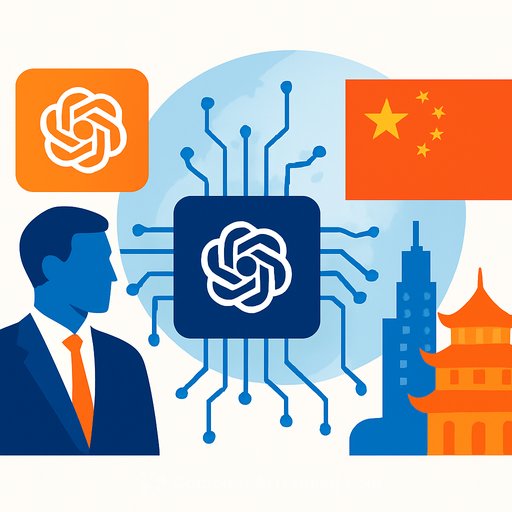'Sovereign AI' Is the New Front in the US-China Tech Contest
OpenAI is partnering with governments to build what it calls "sovereign AI" systems-national AI stacks with tighter control over data, deployment, and policy levers. At the same time, Chinese labs are pushing open source models at scale. The core question for public leaders: do you bet on proprietary platforms, open source, or a hybrid that gives you control without locking you in?
What 'Sovereign AI' Means in Practice
- Control: Local hosting, clear audit trails, and keys you hold-not your vendor.
- Policy fit: Models aligned to national standards for safety, security, and speech policies.
- Continuity: Services that run during outages, sanctions, or vendor disruptions.
- Economic goals: Build local talent and reuse components across ministries to cut cost.
Proprietary vs Open Source: Make the Trade-offs Explicit
- Performance and transparency: Proprietary models often lead benchmarks but are black boxes. Open source gives weight-level access for audits and tuning, with more responsibility on your team.
- Total cost: Factor licensing, inference tokens, GPUs, network egress, storage, and staffing. Run multi-year TCO, not just pilot pricing.
- Compliance and geopolitics: Map exposure to export controls, sanctions, and data localization laws. Review license terms for reusability and public-sector rights.
- Lock-in risk: Proprietary buys speed and support; open source buys flexibility and forkability. Many governments land on a dual track.
- Data protection: Demand on-prem or VPC options, no-retain policies, and segregation of fine-tune datasets.
Context: Beijing's Open Source Push
Chinese tech groups have released competitive open models (for example, Qwen, InternLM, and others). They improve fast through community fine-tunes and multilingual data. For governments, this widens options-but also raises questions on provenance, legal exposure, and supply-chain security.
A Procurement Checklist You Can Use Now
- Use cases: Rank by mission value, risk, and measurability. Start with retrieval, summarization, and forms automation before moving to high-stakes decisions.
- Data classes: Identify PII, classified, and regulated data. Set hard no-go zones for external processing.
- Deployment: Pick on-prem, sovereign cloud, or air-gapped for sensitive workloads. Require GPU portability (NVIDIA/AMD) and containerized delivery.
- Model mix: Define a small set of approved models (proprietary + open) with a broker to route prompts based on sensitivity and cost.
- Evaluation: Use task-specific benchmarks, red teaming, and live A/B tests. Track cost per 1K tokens, accuracy on your data, and failure modes.
- Safety and policy: Content filters, refusal rules, watermarking, and human-in-the-loop for high-risk outputs.
- Contracts: No training on your data, strong SLAs, security attestations, incident reporting, and verified data deletion at exit.
- Legal: Export-control screening, IP indemnity, and open-source license review.
- Audit: Log prompts/outputs, model versions, and system actions for later review.
Architecture Patterns That Work
- RAG-first: Keep your knowledge in vector stores and call models for reasoning. This reduces hallucinations and protects sources.
- Guardrails: Policy checks before and after model calls, plus PII scrubbing.
- Model broker: Route to the cheapest model that meets the accuracy bar; fail over if a provider is down.
- Isolation: Separate tiers for public, sensitive, and classified workloads. Different networks, different models.
- Key and secret control: Your HSM, your keys. Enforce short-lived tokens.
Governance Anchors
- Risk framework: Adopt a standard like the NIST AI Risk Management Framework to set controls and testing gates.
- Compliance posture: Track exposure to export rules via the U.S. Bureau of Industry and Security (BIS) and your national regulators.
- Data governance: Clear policies for retention, deletion, and access. Treat prompts as data.
- Independent oversight: External audits for bias, security, and misuse.
Policy Moves for the Next 6-12 Months
- Set minimum security baselines for any model used in government (testing, logging, incident response).
- Publish model evaluation protocols and share benchmark results across ministries.
- Create a reusable contract playbook with standard clauses and approved licenses.
- Fund shared compute and data platforms to cut duplicate spend.
- Require labeled provenance for training data used in public deployments.
Capability Building
- Stand up an AI Program Management Office to coordinate vendors, standards, and shared services.
- Upskill analysts, procurement, and security teams on prompt design, evaluation, and model risk.
- Use short, role-specific courses to get teams productive fast. See curated options by role at Complete AI Training.
How to Decide: A Simple Playbook
- Pilot: Test 2-3 proprietary and 2-3 open models on your data.
- Score: Accuracy, cost, latency, security controls, and legal risk.
- Pick: Approve one proprietary and one open option per sensitivity tier.
- Scale: Centralize the platform; decentralize use cases with guardrails.
- Review: Quarterly re-bids and re-tests. Swap models when the scorecard demands it.
Bottom Line
Proprietary models offer speed; open source offers control. Most governments will need both, wired into a secure, auditable platform. Make the decision with data, keep an exit plan, and treat AI as critical infrastructure from day one.
Your membership also unlocks:






